
(Photo: Gail showing off a little Moxie (5.9), approaching the good moves before the crux.)
This past Saturday was a fine day in the Gunks. A little warm (high 80's), but sunny. Gail and I expected the place to be a madhouse. So we decided to avoid the crowds by heading to the far side of the Near Trapps. Back in April, Gail and I had great fun in the Easter Time Too area, but we barely scratched the surface. We knew there were a ton of good climbs out there neither of us had tried before.
I hadn't been to the Gunks in a month. Although I'd had the great fortune to climb for four days in a row at the end of May/beginning of June in Squamish, by Saturday that trip seemed like ancient history. I was afraid I'd feel rusty in the Gunks. As we trooped out to the end of the Nears I suggested we start with a route that was somewhat familiar to me: The Main Line (5.8).
Gail has been leading a lot lately and I thought the second pitch of The Main Line would be good for her. She loves roofs and the Main Line roof crux, while burly, is short. I remembered the pro as rock solid. When I led this pitch two years ago I thought the pro was great.
On that day, back in , I was climbing with Vass. I'd hoped to do the whole route but the first pitch of The Main Line was wet. We did the 5.8 first pitch of Ground Control, just to the right, instead. This pitch meets pitch one of The Main Line at its end, finishing at the same set of bolts. I didn't care for the first pitch of Ground Control; I found it awkward and not that much fun. But I loved the second pitch of The Main Line. And then our day came to an abrupt halt. After rapping back to the bolts, I started the second pitch of Ground Control (which is 5.9), but took a lead fall off of some wet holds and sprained a finger, ending our day early.
So on this past Saturday I thought Gail and I could knock off both pitches of The Main Line. I'd lead pitch one, and then Gail could tackle pitch two. And then maybe I'd get back on the second pitch of Ground Control and take care of that one as well.
When we got to The Main Line its corner it was dry so we did it.
I liked pitch one. It is rated 5.7 and I think that is fair. It has several nice, tricky moves on it. It ascends a left-facing corner. When the corner ends at a roof you step right to a slab, then move up to another left-facing corner, which leads you to the belay ledge with a bolted anchor. The larger, second corner is the crux of the pitch but it isn't a corner climb. The crux is getting to the good holds to the left of the corner.
I found the pro to be a little thin on pitch one. It wasn't a crisis, but at the cruxy moments I was often a bit above the gear. I couldn't get a piece right where I wanted it. If 5.7 is your leading limit this pitch might be a bit scary for you.
As we looked up at pitch two Gail wasn't really feeling like leading it. The roof is very intimidating. I'd been there before and thought I knew what to expect so I took the lead again. And the climbing went fine. This is an amazing pitch, with a steep, pumpy stance right beneath the huge overhang, and then one reachy 5.8 move to a jug and easier but still steep climbing up and right to the finish.
Although the climbing was no problem, the pro at the crux gave me fits. I remembered this great placement for a yellow Number 2 Camalot. Two years ago I got this odd but bomber placement right in the middle of the irregular pod above the lip of the roof. But not this time. I couldn't make it work. I tried over and over again. It drove me crazy, and I started to pump out. Eventually my leg started shaking like mad as I tried to force the yellow cam to fit. But it wouldn't go and Gail suggested I step down to rest.
I needed something there. I was confident in the move but the pro below the roof is several feet down and the fall down to the slab would be ugly if you blew it with only that lower piece for protection.
Finally I gave up on the yellow Camalot and got an Alien in one of the cracks on the side of the pod. I thought the piece was okay. It was going to have to do. I did the moves and finished the pitch, which was just as awesome as I remembered. But then when it was her turn Gail struggled with the crux move and when I pulled up on the rope, she was yanked sideways because she'd removed the cam from the pod and my next piece was up and to the right. She couldn't get the angle on the jug, ended up hanging and then couldn't get back on the rock. I lowered her to the belay and had to rap to her. She never got to do the pitch! I felt terrible. Next time I'll place another piece directly above the crux move.
When I rapped down to Gail the annoyances continued. I managed to feed the rope into a notch, getting it stuck. I had to traverse to the right from the bolts until I could yank it free.
It was turning into one of those days.
Back at the bolts, I took a look up at the second pitch of Ground Control. I wanted to do it, but I was already hot, sweaty, and dehydrated. I felt kind of worked over after what was supposed to be our warm-up climb! It seemed like we should go down, have a drink, and find something else.
We ended up doing a lot of fun climbing during the rest of our day, but after our little fiasco on The Main Line I never did feel like I was climbing my best.
We decided next to hit Mac-Reppy (5.11c), which is just left of The Main Line. I was not expecting to get the onsight. 5.11c is just a bit above my pay grade, so to speak. But the crux is one super-hard move at a huge roof, and the rest of the climb has a reputation for being a great 5.8, with a good upper crux involving stemming a corner to get around another huge roof.
I ended up aiding the 5.11 crux. There is a bunch of stiff, faded slings hanging at the crux roof and I imagine many folks bail from there when they get shut down. This station could use some new slings; I would not have felt comfortable using the stuff that is there, as it is pretty junky. But there's no need to bail, people! You can aid the hard bit and the rest of the climb is really nice.
I made a few token efforts at the move. I placed a bomber big nut in the side-pull above the roof and tried to figure out how on earth I would get my feet up into the corner. There is a jug wayyyyyy up there if you can figure out how to stand up and reach it. In retrospect I wish I had made a serious go of it and risked at least one fall. But in the moment I didn't want to waste any more of our day and so instead after a few exploratory attempts at the move I decided it wasn't happening. I pulled on the draw attached to my nut, placed another higher nut, extended a sling on it, and stepped into the sling while I pulled on the higher piece. This got me over the lip of the roof. I could then reach the jug and resume free climbing. I have no experience in this kind of French-free climbing and I found it simple enough. If I can do it then so, dear reader, can you.
The rest of the climb is very worthwhile. There are some really nice 5.8-ish face moves low, just off the ground, and then the upper 5.8 crux is great. Be aware that you have to fully commit to stemming way out at the upper crux roof and getting the first holds above the overhang before you can place gear. Once you are fully in it, though, the pro is great for the few 5.8 moves to the top. It is very exciting. If you are considering attempting the lower 5.11 crux then you shouldn't be too freaked out by the pro situation above.
After Mac-Reppy, we walked further down the cliff, considering and rejecting several candidates until we got to the very end of the Nears. There we found Up In Arms (5.9), a striking diagonal crack climb up an overhanging wall. The crack is jagged, and it widens from fingers to hands as you go up. And this being the Gunks, there are also horizontals to grab along the way. There is pro everywhere.

(Photo: Striking a pose on Up In Arms (5.9).)
This is a quality climb, really strenuous for 5.9 and very unusual for the Gunks. I admit I struggled in this steep section. I took a few hangs. I didn't jam much; mostly I threw in jams when I wanted to place gear. All I could think of was how thirsty and tired I felt, after just a few pitches. I realized that it was time to admit that the summer was really upon us. I might need to dial it back a bit on these hot days.
The diagonal crack system takes you left to a chimney, which is more of a gully, really. It is easy climbing up the gully and then the pitch gets weird again near the top of the gully as you hand traverse right using a little bit of stemming until finally you commit to the overhanging wall again for a move or two around a corner to the main face and the belay tree.
We decided to do pitch two, another very unusual, interesting pitch. This one is reputed to be 5.8. First you step across the gully to an arete below a roof. You have to figure out a way to move up and around the arete onto the face beneath the roof, and then pull over the roof to the right of a crack that runs straight out the underside. I enjoyed all of the climbing on this pitch, but it doesn't appear to get done very often. I didn't see any chalk and the holds above the roof were a little dirty. I felt supremely sandbagged at the roof. I made it over and I know I was hot and tired, but still, I believe I have enough experience to judge when a roof in the Gunks should be 5.8 and this is not such a roof! I thought it was hard 5.9, with big moves to so-so holds. (Gail employed a heel hook with a mantel, not exactly your average 5.8 maneuver.) The pro is good, though. The roof is a fitting capper to a very intriguing route. Up In Arms packs a ton of interesting challenges into two short pitches.
There is a belay tree with slings at the very top of Up In Arms but please don't use it. The slings are all old and crusty and the tree itself looks none too healthy. If I'd had a knife with me I would have cut the crappy tat off of that tree. There are other trees behind for the belay and you can walk off down Smede's Cove. The trail down a rocky drainage is easy to find and it only takes a few minutes.

(Photo: Negotiating the lower bits of Moxie (5.9).)
Once we returned to our packs we walked back the other way and decided to try Moxie (5.9). This is a short pitch but a good one. The climb follows a weakness up and right to a blank-looking corner. The crux is finding a way to move up into the corner and then around onto the face and the rap tree. I enjoyed the 5.7/5.8-ish climbing up to the crux corner and then felt stuck for a minute at the crux. It is a bit of a puzzler, as it seems there are no holds! Anyway there is good pro right there for you at your hip while you sort it all out. I don't want to reveal the solution; I'll just say that, as is typical in the Gunks, the answer to the corner isn't inside but outside. I was relieved to onsight this 5.9, after my struggles on Up In Arms.
With order thus restored to the universe, we made an attempt at another 5.9, our final route of the day: Cherokee, a single-pitch 5.9 that is afforded two stars by Dick Williams in his latest guidebook.

(Photo: Gail at the crux of Cherokee (5.9).)
Dick describes the crux, which goes up a shallow open book about 20 feet up, as being harder for shorter people. I disregarded this warning. He says that all the time, and whenever I hear someone say a climb is height-dependent I dismiss it as weak excuse-making. Real men use technique, they don't whine about reachy moves.
So I had no worries, until I went right up Cherokee and got completely shut down at the crux. It was a just reward for my hubris, but I really don't think height is the issue. It seemed to me the route requires you to use terrible footholds and a tiny two-finger undercling hold in order to reach up to the jug. I got a good brassie nut in the key hold. It did not block the hold. But the hold sucks; it is one pad deep! I kept trying to step up but then kept stepping down. I never took a fall but I just couldn't see this move working out. It felt like I was just going to slip right off. I think a tall person would have to make the same move.
Eventually I said screw it, grabbed the draw on the brassie and stepped up to the good hold. It was my second French-free lead of the day. I guess I really should have gone for it at least once and made the move or taken the fall. I knew my pro was good. Anyway, after I aided the crux the rest of the pitch was really quite nice, with lots of steep 5.8 moves up orange rock. There is some loose rock right after the crux, and a wedged block near the top that gave me the willies. And I thought it was kind of run out through the middle of the pitch. Gail, on top rope, was just as mystified by the crux move. She aided it too after deciding this was the sort of move that could make you rip a pulley or tendon.
I'd like to say that I'll go back to Cherokee on a cooler day when it feels less greasy. But I'm not sure I ever really want to go back and do that crux move. It does seem like an injury waiting to happen. Apart from that move it is a very good pitch, steep and consistent. It just keeps coming at you.
We still had hours of daylight to go but after Cherokee we were both whipped. We decided to call it a day. Another party walked up to Cherokee as we were packing up and as we left the leader was experiencing the exact same WTF mystery as we did at the crux, so I walked away feeling like at least I hadn't lost my mind.
I felt a little let down by my performance on the day. I've felt so good on every 5.9 I've tried in the Gunks for what seems like an eternity; I was surprised at how challenging I found the ones I tried on Saturday. But I came down with a mean head cold in the last couple of days so maybe I have an excuse. Or maybe I just need to stop sucking! Tomorrow is another day.
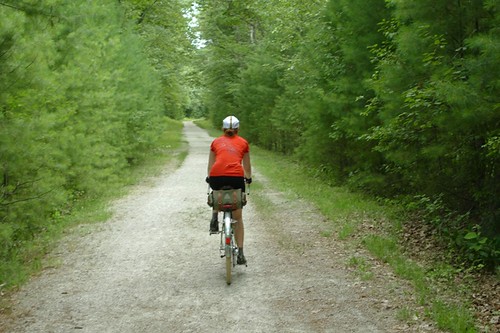 I've decided that I will definitely be going to theDeerfield Dirt-Road Randonnée (D2R2) this year - a scenic ride along New England dirt roads that will take place in August. The 40 mile route is said to be tame in comparison to the longer options, but I still need to get used to riding on dirt roads if I am going to do it. So we began by exploring some of the ones close to our usual cycling routes: the Narrow Gauge Rail Trail that runs fromBedford to Billerica,and the Battle Road Trail that runs from Lexington to Concord. Both of these are pretty short (3 miles and 5 miles), but they are the only dirt roads I know of around here that aren't too technical. We incorporated them into our regular 40 mile ride, setting off on bikes with wide tires.
I've decided that I will definitely be going to theDeerfield Dirt-Road Randonnée (D2R2) this year - a scenic ride along New England dirt roads that will take place in August. The 40 mile route is said to be tame in comparison to the longer options, but I still need to get used to riding on dirt roads if I am going to do it. So we began by exploring some of the ones close to our usual cycling routes: the Narrow Gauge Rail Trail that runs fromBedford to Billerica,and the Battle Road Trail that runs from Lexington to Concord. Both of these are pretty short (3 miles and 5 miles), but they are the only dirt roads I know of around here that aren't too technical. We incorporated them into our regular 40 mile ride, setting off on bikes with wide tires.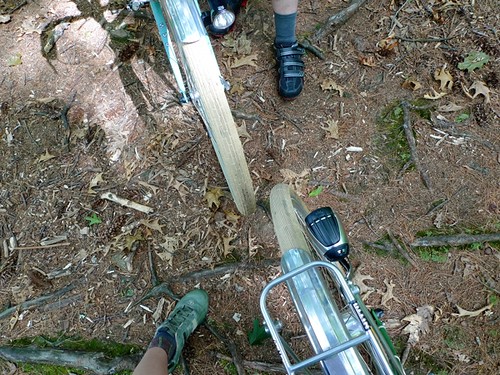 650B x 42mm Grand Bois Hetre tires on my Rivendell, and 700C x 50mm Schwalbe Fat Frank tires on his Surly. I know that some prefer to ride mountain bikes and be more upright on trails, but I really like the feeling of a roadish bike with dropbars on this terrain: My weight feels well-distributed and the speed and maneuverability seem to work in my favour when going either over or around tricky patches.
650B x 42mm Grand Bois Hetre tires on my Rivendell, and 700C x 50mm Schwalbe Fat Frank tires on his Surly. I know that some prefer to ride mountain bikes and be more upright on trails, but I really like the feeling of a roadish bike with dropbars on this terrain: My weight feels well-distributed and the speed and maneuverability seem to work in my favour when going either over or around tricky patches.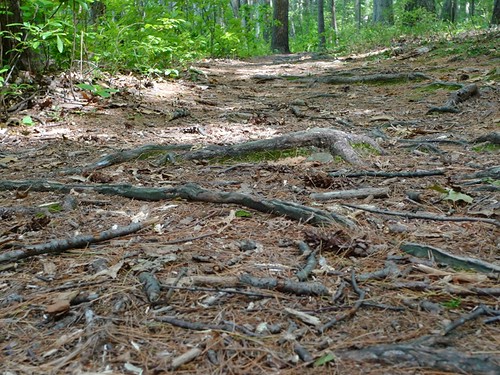 I am fairly certain that I would not enjoy a trail so technical as to require a dedicated mountain bike.Even this offshoot of the main path was too much.
I am fairly certain that I would not enjoy a trail so technical as to require a dedicated mountain bike.Even this offshoot of the main path was too much.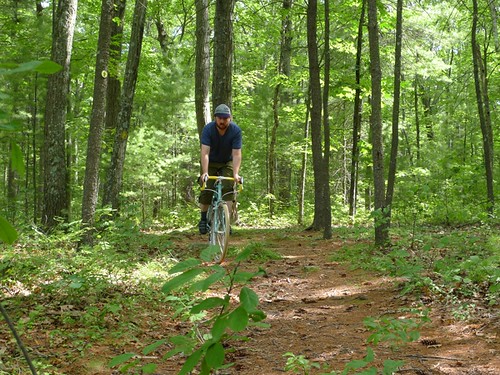 When there are rocks and roots jutting out every which way, navigating around them is stressful - while going over them feels like riding a pogo stick. I don't think this kind of surface is for me.
When there are rocks and roots jutting out every which way, navigating around them is stressful - while going over them feels like riding a pogo stick. I don't think this kind of surface is for me.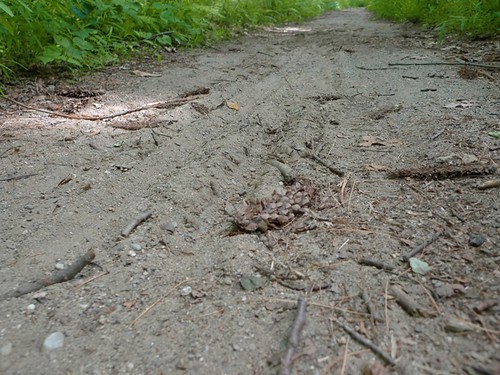 But the surface of the main paths looked like this most of the time: Mainly packed dirt with some gravel, and occasional stretches of sand. These things I am more or less okay with.
But the surface of the main paths looked like this most of the time: Mainly packed dirt with some gravel, and occasional stretches of sand. These things I am more or less okay with.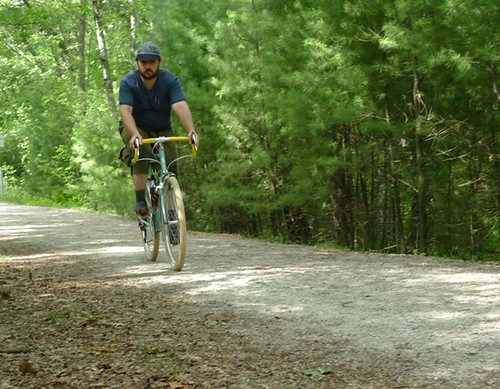 We maintained a speed of about 12-13 mph most of the time on this surface, and I was fairly comfortable. When gravel is loose, it can feel like it's slipping out from under your tires - but the main thing is to get used to that sensation and just keep going. Easier said than done of course - especially when cycling down a winding incline. Even a gentle incline and a subtle turn can incite panic if it feels like your tire is slipping sideways. But braking is a bad idea and trying to put a foot down is a bad idea - pretty much just trusting in the bike's momentum and continuing seems to be the way to deal with this.
We maintained a speed of about 12-13 mph most of the time on this surface, and I was fairly comfortable. When gravel is loose, it can feel like it's slipping out from under your tires - but the main thing is to get used to that sensation and just keep going. Easier said than done of course - especially when cycling down a winding incline. Even a gentle incline and a subtle turn can incite panic if it feels like your tire is slipping sideways. But braking is a bad idea and trying to put a foot down is a bad idea - pretty much just trusting in the bike's momentum and continuing seems to be the way to deal with this.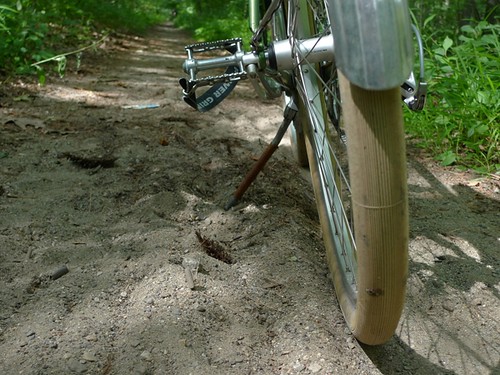 I did have a minor incident when we went over a stretch of deep sand. I was fine through most of it, but toward the end the mere awareness that I was cycling through sand just got too much and I lost my nerve. The bike started to topple and I sort of half-fell forwardin slow motion (crotch onto toptube - ouch!), while desperately clutching the handlebars so that the bike itself wouldn't fall. Given that this hardly even qualifies as a fall, I am glad it happened: Now I understand how the bike behaves if I slow down in sand.
I did have a minor incident when we went over a stretch of deep sand. I was fine through most of it, but toward the end the mere awareness that I was cycling through sand just got too much and I lost my nerve. The bike started to topple and I sort of half-fell forwardin slow motion (crotch onto toptube - ouch!), while desperately clutching the handlebars so that the bike itself wouldn't fall. Given that this hardly even qualifies as a fall, I am glad it happened: Now I understand how the bike behaves if I slow down in sand.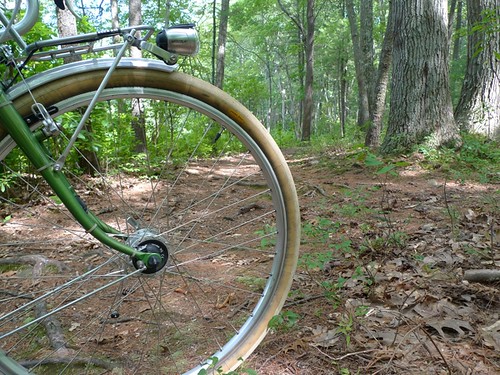 After this dirt road excursion, I am still not not sure how I feel about cycling off-road. Riding in the woods was nice and I do appreciate the fresh air and the quiet of being away from busy roads. But the slower speed felt limiting and I was very glad to be back on pavement and cycling at 20mph once we were done with the trails. The technical aspect - developing skills to transcend difficult terrain on a bicycle - is just not exciting to me at all in of itself. The aspect I do like is the feeling of exploring, and I hope to find some other trails that are longer and lead somewhere more interesting next time. What appeals to me about the D2R2 is the vastness and diversity of terrain it promises, with beautiful riverside views. It's a legendary ride, and I hope to be comfortable enough on dirt roads to complete it in August. Any advice for local routes to practice on most welcome!
After this dirt road excursion, I am still not not sure how I feel about cycling off-road. Riding in the woods was nice and I do appreciate the fresh air and the quiet of being away from busy roads. But the slower speed felt limiting and I was very glad to be back on pavement and cycling at 20mph once we were done with the trails. The technical aspect - developing skills to transcend difficult terrain on a bicycle - is just not exciting to me at all in of itself. The aspect I do like is the feeling of exploring, and I hope to find some other trails that are longer and lead somewhere more interesting next time. What appeals to me about the D2R2 is the vastness and diversity of terrain it promises, with beautiful riverside views. It's a legendary ride, and I hope to be comfortable enough on dirt roads to complete it in August. Any advice for local routes to practice on most welcome!












 The site of the burying ground for the 44th Regiment is marked “Ind 3” at the bottom center of the diagram.
The site of the burying ground for the 44th Regiment is marked “Ind 3” at the bottom center of the diagram. The tall post to the right marks the center of the burying ground for the 44th Indiana Infantry. The stones in the foreground belong to men from Iowa regiments.
The tall post to the right marks the center of the burying ground for the 44th Indiana Infantry. The stones in the foreground belong to men from Iowa regiments.








 Someday, I'd like to spend some time researching these men... a quick search of the Internets garnered this bit of information on marker 441, shown above: George Weamer enlisted while a Columbia City, Indiana resident as a Private in Company G, 44th Indiana Volunteer Infantry on November 22, 1861, mustering into service the same day. He was transferred to Company E on January 2, 1862 and was wounded April 6, 1862 at the Battle of Shiloh. He died of his wounds April 17, 1862.
Someday, I'd like to spend some time researching these men... a quick search of the Internets garnered this bit of information on marker 441, shown above: George Weamer enlisted while a Columbia City, Indiana resident as a Private in Company G, 44th Indiana Volunteer Infantry on November 22, 1861, mustering into service the same day. He was transferred to Company E on January 2, 1862 and was wounded April 6, 1862 at the Battle of Shiloh. He died of his wounds April 17, 1862. After the tournament, we went to a cookout. They combined the horseshoe tournament players with the pickleball tournaments players in the cookout. We had lots of fun getting to know the locals better.
After the tournament, we went to a cookout. They combined the horseshoe tournament players with the pickleball tournaments players in the cookout. We had lots of fun getting to know the locals better.


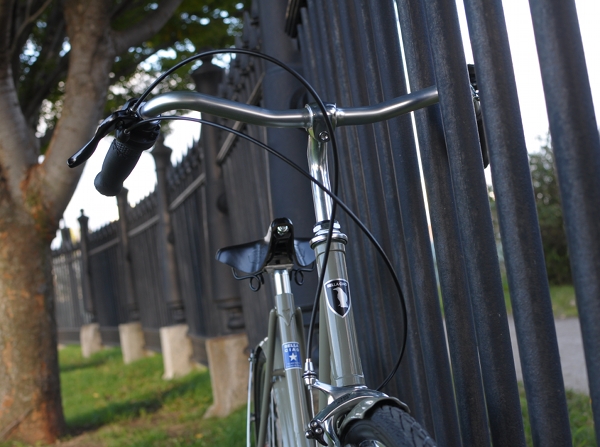 A couple of weeks ago I received aBella Ciaobicycle as part of a work-related trade. I have never been compensated for anything in bicycle before, but I think I could get used to this if absolutely forced to (at least for the benefit of providing test ride reports for my readers, right?). The bike was assembled with my preferences in mind, and I was invited to offer an honest critique.
A couple of weeks ago I received aBella Ciaobicycle as part of a work-related trade. I have never been compensated for anything in bicycle before, but I think I could get used to this if absolutely forced to (at least for the benefit of providing test ride reports for my readers, right?). The bike was assembled with my preferences in mind, and I was invited to offer an honest critique.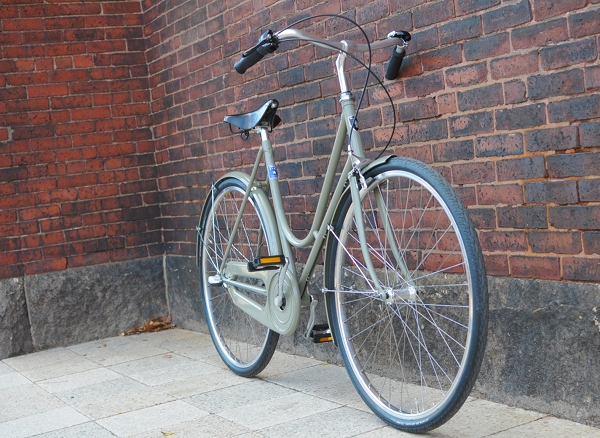 The bicycle is aBella Ciao"Corvo Citta Donna". The model name translates into something like "urban raven" anddonnaindicates that it is the lady's version. The colour (chosen by me) is "verde arsenale" - a pastel army green. Half a dozen other colours are available as well. The "Corvo Citta" models can be ordered as single speeds, 3-speeds, or 7/8-speeds, with or without coaster brake. I asked for a 3-speed coasterbrake version. The accessories are either honey or black, depending on the frame colour, and mine came with the black accessories package.
The bicycle is aBella Ciao"Corvo Citta Donna". The model name translates into something like "urban raven" anddonnaindicates that it is the lady's version. The colour (chosen by me) is "verde arsenale" - a pastel army green. Half a dozen other colours are available as well. The "Corvo Citta" models can be ordered as single speeds, 3-speeds, or 7/8-speeds, with or without coaster brake. I asked for a 3-speed coasterbrake version. The accessories are either honey or black, depending on the frame colour, and mine came with the black accessories package.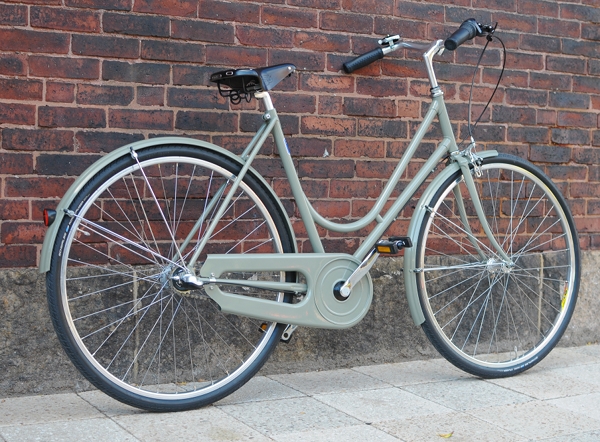 Bella Ciao frames are individually hand-made (brazed and lugged) by a small family-owned manufacturer in Northern Italy that has been building frames for generations. The standard models are cro-moly steel, though there are also limited editions made of Columbus tubing.Standard features on the Corvo Citta Donna include the classic Italian frame construction, 700C wheels with alloy rims, body-coloured fenders, an enclosed chaincase with a rear opening, leather saddle and grips,rear reflector,and a brass bell.
Bella Ciao frames are individually hand-made (brazed and lugged) by a small family-owned manufacturer in Northern Italy that has been building frames for generations. The standard models are cro-moly steel, though there are also limited editions made of Columbus tubing.Standard features on the Corvo Citta Donna include the classic Italian frame construction, 700C wheels with alloy rims, body-coloured fenders, an enclosed chaincase with a rear opening, leather saddle and grips,rear reflector,and a brass bell.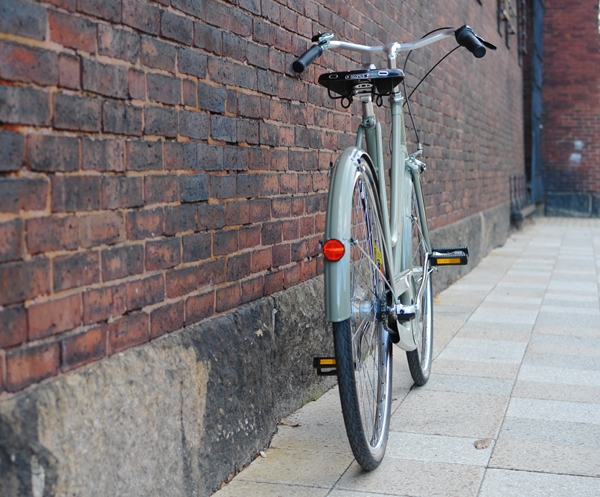 The frame is made in size 54cm (21.5") only, measured the "standard" way. This is an important point, especially if you are trying to compare the Bella Ciao to the Abici,whose sizing is measured differently. I would say that the Bella Ciao frame isslightly larger than the bigger of the two Abici frames.
The frame is made in size 54cm (21.5") only, measured the "standard" way. This is an important point, especially if you are trying to compare the Bella Ciao to the Abici,whose sizing is measured differently. I would say that the Bella Ciao frame isslightly larger than the bigger of the two Abici frames. With its hardy tubing, modest lugwork, and thick powdercoating, the "Corvo Citta" is attractive, but decidedly utilitarian.
With its hardy tubing, modest lugwork, and thick powdercoating, the "Corvo Citta" is attractive, but decidedly utilitarian.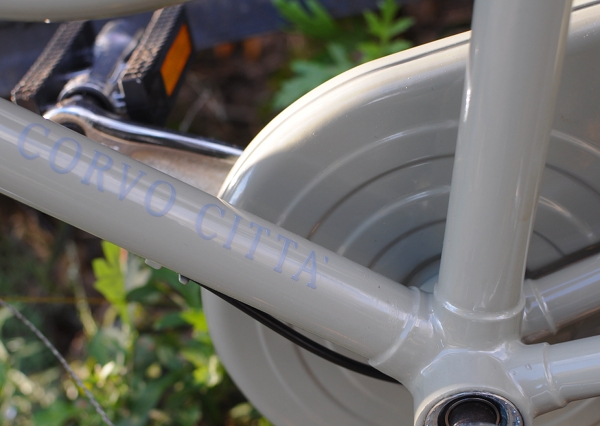 It is not a delicate bicycle by any means; the frame feels as if it can take anything that life has to offfer.
It is not a delicate bicycle by any means; the frame feels as if it can take anything that life has to offfer. The lugged fork crown warms my heart; very nicely done. And look at the body-coloured cable guide braze-ons.
The lugged fork crown warms my heart; very nicely done. And look at the body-coloured cable guide braze-ons. The only part of the frame that is not lugged, is the connector between the curved top tube and downtube. But if I have to choose between this and the fork crown, the latter is infinitely more important to me. (The connector on my Pashley was not lugged either.)
The only part of the frame that is not lugged, is the connector between the curved top tube and downtube. But if I have to choose between this and the fork crown, the latter is infinitely more important to me. (The connector on my Pashley was not lugged either.)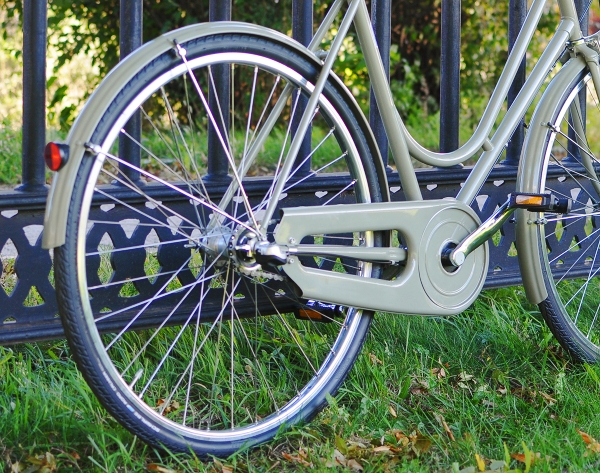 I like the elegant chaincase, and the interesting thing, is that despite being steel it is absolutely silent.
I like the elegant chaincase, and the interesting thing, is that despite being steel it is absolutely silent.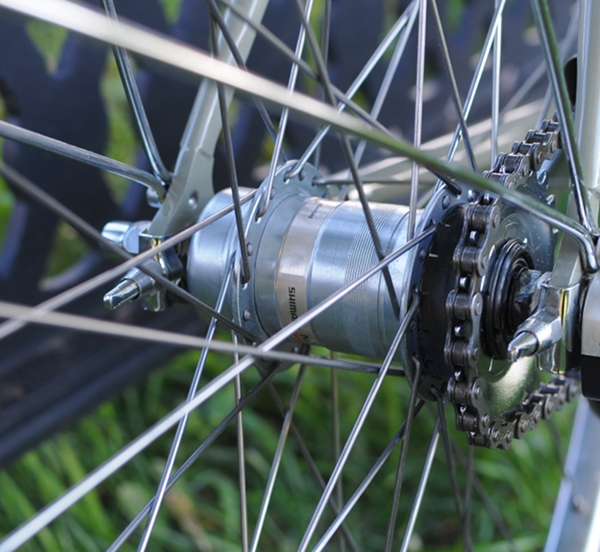 The Bella Ciao has straight fork ends, which I prefer on an internally geared hub bicycle. There are also chain tensioners installed - a detail the Co-Habitatant found especially exciting.
The Bella Ciao has straight fork ends, which I prefer on an internally geared hub bicycle. There are also chain tensioners installed - a detail the Co-Habitatant found especially exciting.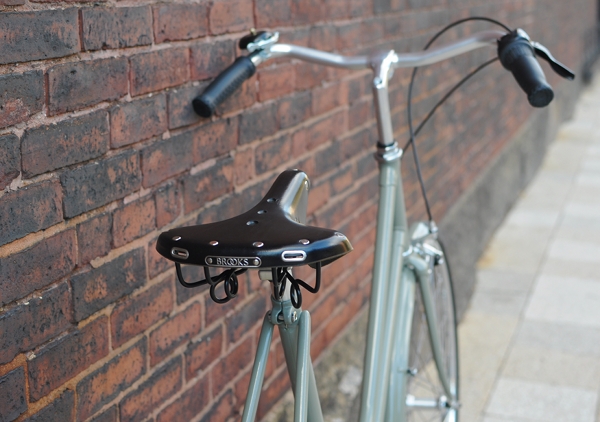 The bicycle arrived to me with a Brooks B17S saddle, but I immediately replaced it with a B72. I am not sure why both Bella Ciao and Abici use B17 saddles on their city bikes, but I think they need to rethink this choice - it is not an appropriate model for an upright ride, especially for women. The B72, on the other hand, feels absolutely at home here.
The bicycle arrived to me with a Brooks B17S saddle, but I immediately replaced it with a B72. I am not sure why both Bella Ciao and Abici use B17 saddles on their city bikes, but I think they need to rethink this choice - it is not an appropriate model for an upright ride, especially for women. The B72, on the other hand, feels absolutely at home here. 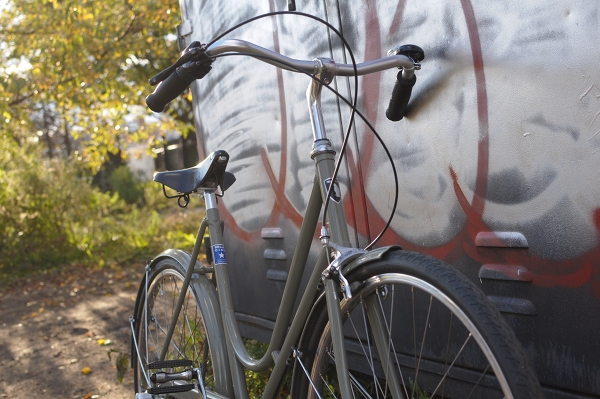 The minimal insignia on the Bella Ciao include a small headbadge on the head tube featuring the black raven logo, the "Corvo Citta" model name inscription near the bottom bracket, and a "fatto a mano in Italia" sticker on the seat tube.
The minimal insignia on the Bella Ciao include a small headbadge on the head tube featuring the black raven logo, the "Corvo Citta" model name inscription near the bottom bracket, and a "fatto a mano in Italia" sticker on the seat tube.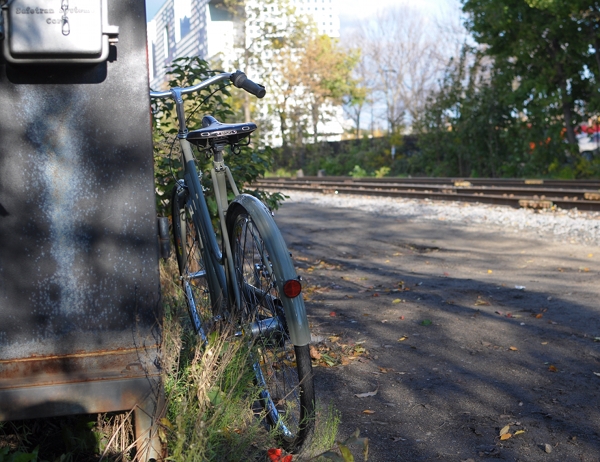 Moving on to ride quality... The most notable sensation I got from the Bella Ciao, was that it did not feel like a new bicycle. It felt very familiar, like an old bike that I have always owned.Lovers of classic bicycles complain that "there is no such thing anymore as a simple, well-made, lugged steel 3-speed bike". Well, I think the Bella Ciao isexactlythat. It is easy. It is comfortable. It is uncomplicated. It is not as laid back as a Dutch bike, but definitely not too sporty either (more relaxed than an Abici). It is maneuverable but unaggressive. It is just a bike. A very nice bike that anybody can ride, and that is light enough for anybody to lift.
Moving on to ride quality... The most notable sensation I got from the Bella Ciao, was that it did not feel like a new bicycle. It felt very familiar, like an old bike that I have always owned.Lovers of classic bicycles complain that "there is no such thing anymore as a simple, well-made, lugged steel 3-speed bike". Well, I think the Bella Ciao isexactlythat. It is easy. It is comfortable. It is uncomplicated. It is not as laid back as a Dutch bike, but definitely not too sporty either (more relaxed than an Abici). It is maneuverable but unaggressive. It is just a bike. A very nice bike that anybody can ride, and that is light enough for anybody to lift. When a bicycle is this easy, comfortable and undemanding, you end up riding it all the time... which, ironically, ushers in my next complaint: Where are the lights? And more importantly, where is the rack? I would love to ride the Bella Ciao regularly for transportation, but there is nowhere to attach my bag and all the other stuff I take along, which is frustrating. The design of the bicycle will accommodate the VO Constructeur rear rack, and when I have the money I might get one. But I think that a rack in the style you see on some of these bicycles would be more appropriate. Anybody know where I could source one?
When a bicycle is this easy, comfortable and undemanding, you end up riding it all the time... which, ironically, ushers in my next complaint: Where are the lights? And more importantly, where is the rack? I would love to ride the Bella Ciao regularly for transportation, but there is nowhere to attach my bag and all the other stuff I take along, which is frustrating. The design of the bicycle will accommodate the VO Constructeur rear rack, and when I have the money I might get one. But I think that a rack in the style you see on some of these bicycles would be more appropriate. Anybody know where I could source one?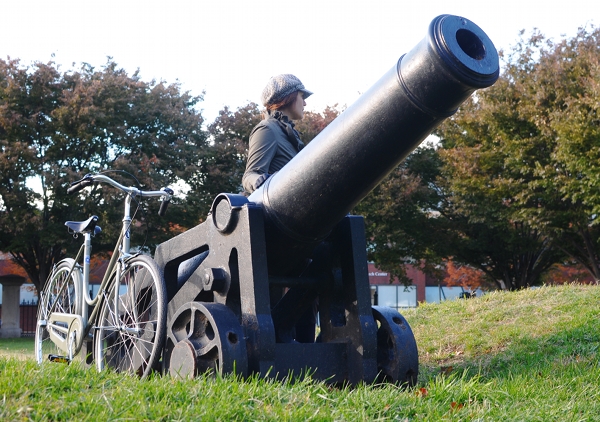 The Bella Ciao"Corvo Citta Donna" might just be the closest I have tried to an "all around, normal" bike out there today among classic lugged bicycles. And that was rather unexpected, given the quirkiness of the manufacturer's self-presentation. Free-association collages, stories of resistance against fascism - it is enough to raise the eyebrows of some and to make others wonder whether Bella Ciao is in reality a contemporary art project rather than a real bicycle company. Well, I suppose there is no reason it can't be both...
The Bella Ciao"Corvo Citta Donna" might just be the closest I have tried to an "all around, normal" bike out there today among classic lugged bicycles. And that was rather unexpected, given the quirkiness of the manufacturer's self-presentation. Free-association collages, stories of resistance against fascism - it is enough to raise the eyebrows of some and to make others wonder whether Bella Ciao is in reality a contemporary art project rather than a real bicycle company. Well, I suppose there is no reason it can't be both...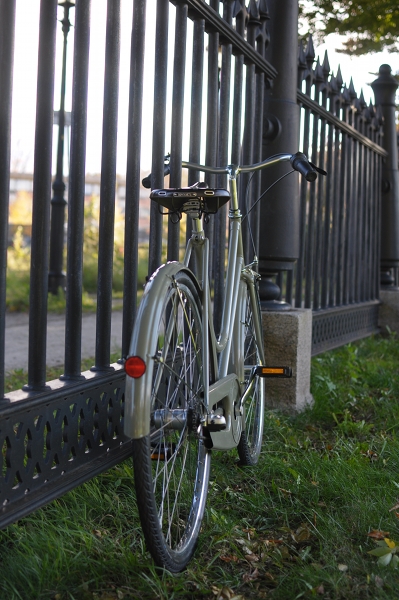 Though currently only sold in the EU, Bella Ciao is considering North American distributors and the bicycles may be available for sale in the US sometime in . The Corvo Citta Donna would certainlybe welcomed by women looking for more options in classic city bicycles.
Though currently only sold in the EU, Bella Ciao is considering North American distributors and the bicycles may be available for sale in the US sometime in . The Corvo Citta Donna would certainlybe welcomed by women looking for more options in classic city bicycles.